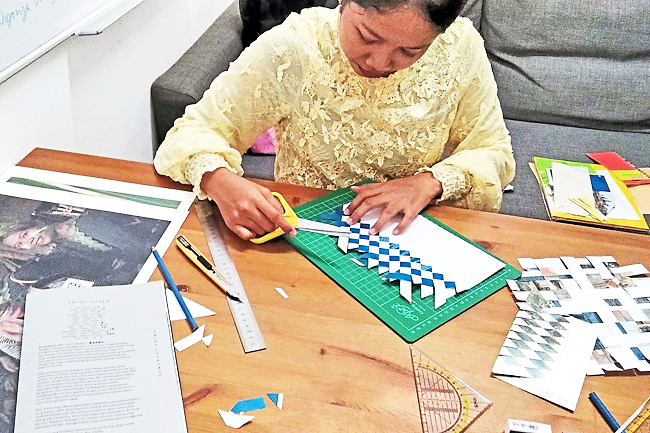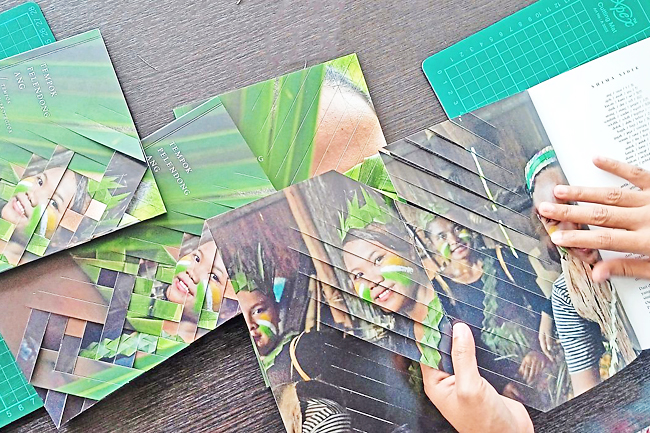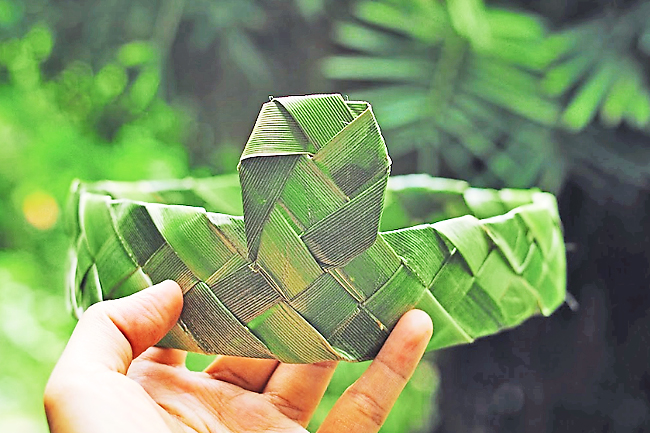ANN/THE STAR – Tempok Pelendong Ang or Tempok My Protector is compilation of photography works by Shima Sidek, a 31-year-old Jakun woman who hails from Kampung Mikang in Pahang, Malaysia.
Recorded in Jakun, then translated into English and traditional Chinese script, the two-part photobook was authored and produced by fellow photographer Jeffrey Lim, who Shima met three years ago on another project. The current offering features a photo essay and portrait photography, which provide perspective and a path into Shima’s world.
“Photography is means for me to share my thoughts and feelings with others,” said Shima in a recent interview.
“I want my photographs to speak.”
Shima’s goals revolve around creating an awareness about Orang Asli culture, and inspiring the younger generation of her community to be able to identify, value and learn about their craft heritage.
“I wanted this book to highlight our traditional craft of mengkuang leaf weaving to the young Orang Asli community in this country, especially to the Jakun tribe, my own people,” she shared.



“Most crafts such as mengkuang weaving are only practised by the older generation these days; some of the young people don’t even know about it. Maybe only a handful of them may be interested.”
Shima said it’s so important to keep this type of heritage knowledge alive so others are able to appreciate the art, customs and culture of the local Orang Asli community.
“It also gives other people a glimpse into our villages and our lifestyle, which many are still unaware about. Something as simple as a photography exhibition featuring pictures of life in the kampung, coupled with a sale of handicrafts made by the Orang Asli is a great introduction to the Orang Asli community. We’ve seen this work before in the past.”
IMPORTANCE OF EDUCATION
Graduating in Fine Arts from the Universiti Malaysia Sarawak (Unimas), Shima always did well at school, even with the struggles she faced coming from an indigenous tribe.
Born and raised in a small village with only about 85 people, education has never really been at the forefront of the community.
“There are 11 of us in my own home, including my parents, four of my own siblings, and three cousins. Many of the villagers go to school, but just as many don’t,” said Shima, elaborating on how one of the biggest challenges the Orang Asli face is that many of the villagers don’t have many long-term goals and don’t see any real need to change their circumstances having been uprooted from their tradition way of life and interdependence with nature.
Shima, however, enjoyed schooling and saw education as a way to improve herself. What’s more is that she was able to hone her talent in art.
“From the time I was in primary school I was really interested in art. I remember aspiring to be an artist someday. After finishing Form 6, in 2013, I received an offer to study at Unimas in the faculty of Applied and Creative Arts.”
There Shima was exposed to painting, ceramics and photography, but settled on photography because she enjoyed taking photos, and found it almost therapeutic to be able to document her innermost thoughts this way.
She was also inspired to create, weaving together a personal narrative of identity, resilience and cultural revival.
“Based on my research, for my final year project I was able to come up with a work called Antara 2 Generasi (Between 2 Generations),” she recalled her efforts in creating a self-portrait, which was a clever combination of a photograph and weave and reflected the internal crisis between her indigenous origins and projected self.
Life at Unimas, Shima reminisced, was good and there were a few other Orang Asli students there too. “We had the opportunity to interact with students from other states and countries as well and I felt proud to be able to be able to do that. What’s more is that I was able to pass with a credit and obtain my Bachelor’s Degree!”
A feat well worth noting as it is rare for the Orang Asli of her kampung to pursue higher education.
Shima said that she never really considered herself an ‘artist’ until her friends started noticing her potential and appreciating her work. Only then did she begin having ambitions to use her photography skills and do something positive for her community.
“I guess that’s when I realised my own voice as an artist within the Jakun and Orang Asli community. And I felt a responsibility to present or showcase my community through photography so more of society would know about our lives, our culture, our heritage and rights.”
Tempok Pelendong Ang continues in that vein and is an ode to the indigenous headdress, through which Shima attempts to rediscover herself. Orang Asli wear the woven tempok for celebrations as well as when outside folk are invited into a village for programmes. Shima explains that it is a representation of their identity. The term ‘Pelendong Ang’ more specifically identifies the tempok as a protection for Shima; In Jakun, ‘ang’ means ‘I’.
Shima explained how the headdress works: “When I wear this tempok, it is our belief that my spirit will be revived, however much it has waned. It protects me.”
One of the reasons she chose to highlight the tempok was because Shima feels the headdress is being slowly forgotten by the community, who no longer value its purpose and place.
“It is a symbol of our people’s art and culture, our traditional costume. They come in numerous designs and highlight our community’s skills at weaving.” Despite its title, the book ventures beyond the headdress, and encompasses other aspects of Jakun community life and its surrounding environment.
In her artist statement, Shima said that it was challenging to find the right photos which would represent the community as a whole, and not just herself. The photos also had to have aesthetic value and where possible she tried to inject humour or satire as well.
Shima is happy with the book and said that her ongoing commitment is to persist in such endeavours for the years ahead, while simultaneously striving to inspire and motivate individuals from Orang Asli communities in Malaysia towards socio-economic advancement.
WORKING TOGETHER
Lim, known for his Kanta Portraits Project and box camera, in which he travels through Malaysia and the region taking portraits of people from different cultures, crossed paths professionally with Shima in 2020.
“We actually met in 2017 during an indigenous festival in Keningau, Sabah, when I was touring with my Kanta project. But it was only in 2020 that I was introduced to her and her artwork. Our conversations on her outlook and her art intrigued me,” Lim said.
“I was curating an exhibition on Malaysian photobooks in Taipei – the Lightbox Photobook Library, Taipei, Taiwan – and part of my directive was to include narratives written from the perspectives of indigenous peoples. So I was actively seeking out photographers and artists who would be interested in producing their work in the form of a book.
Lim managed 11 commissioned photobooks for the project, five of which he designed and developed with photographers and artists themselves. Shima was one of the five.
Lim said: “It took about three to five months to produce a photo maquette, which was sent to the photobook library in Taipei.”
At around the same time, Lim was able to convince Shima to apply for a publishing grant from MyCreative Ventures, a government investment arm that offers grants to arts and culture workers in Malaysia.
“Shima managed to get a Creative Industry Recovery Grant for Literature and Publishing under Pelan Jana Semula Ekonomi Negara (Penjana) to publish a book. And so we began revising and developing what we had done for Taipei for a new publication. In 2022 we managed to produce the book,” explained Lim.
“However, I could only find the time to organise an official launch for the book now.”
Lim said that both Shima and he were very much involved in the process of making the photobook.
“I’m a print and book designer but the creative process behind it needed analytical thinking from both of us. Most of Shima’s photography had solitude and figurative elements of self injected into their composition, so it was essential that she be part of the whole process.”


